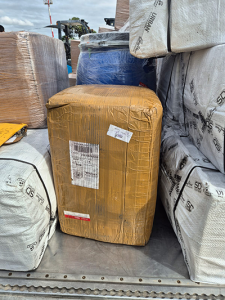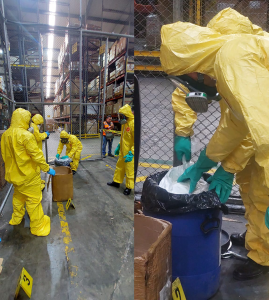The SAT is steadily advancing in the modernization of customs processes related to cross-border e-commerce, consolidating Guatemala’s position as a regional benchmark in trade facilitation and intelligent customs control.
Data-driven modernization technology
In 2019, with the support of the World Customs Organization (WCO), the SAT conducted a Time Release Study (TRS) at airports, seaports, and land borders. The results made it possible to identify areas for improvement and design a National Action Plan focused on automation and digitalization of the logistics chain.
As a result, clearance times were significantly reduced, and risk management was strengthened. Currently, 75% of air cargo is released in less than 24 hours, reflecting the efficiency of the new customs model, based on simplified processes and a robust IT system using blockchain technology.
Innovation and Traceability in Customs Management
The new centralized document management system enables the secure electronic exchange of information among airlines, operators, and authorities. Electronic Air Waybills (e-AWB) are published on blockchain, ensuring transparency, traceability, and data security. In addition, the SAT has incorporated machine learning models to automate processes and enhance early detection of risks in customs operations.
Expedited Clearance of Courier Shipments
International e-commerce has led to a substantial increase in express courier shipments. To meet this demand, the SAT implemented a specific procedure for personal-use consignments valued up to USD 1,000, equivalent to the low-value category defined by the WCO.
The process is fully digital: the carrier transmits the manifest in advance, the system generates the simplified declaration and performs risk analysis. When no issues are detected, the user can pay online and obtain immediate release. The clearance process for express courier shipments is as follows:
- The carrier transmits the electronic manifest before the goods arrive.
- The Customs Administration of Guatemala receives the manifest, and the IT system automatically converts it into a simplified declaration and performs the risk analysis.
- If the risk analysis results in release without inspection, the system notifies the user of the amount of taxes to be paid (12% VAT and import duties ranging from 0% to 20% as per the Central American Tariff).
- If the analysis calls for immediate verification, the carrier presents the shipment in the specialized area at the air terminal for classification and valuation. Customs verifies the accuracy of declared values and classifications and notifies any adjustments.
- Taxes are paid, and the goods declaration is generated.
- The carrier receives the declaration electronically after payment confirmation.
This system has accelerated package delivery, reduced logistics costs, and strengthened operational traceability.

Risk management and international cooperation
Since implementing the WCO Cargo Targeting System (CTS) in 2022, the SAT has enhanced its ability to detect illicit goods and manage risks. Notably, chemical precursors used in the illicit production of fentanyl have been intercepted using automated risk indicators.
Additionally, the SAT signed an agreement with the civil association CLADEC Guatemala, representing courier companies, allowing advance information exchange with 14 courier firms to strengthen traceability and control of international shipments.
An ongoing challenge is integrating data with e-commerce platforms and providers to combat under-valuation of goods and improve verification of declared prices.
Digitization of the postal process
Together with the Directorate General of Posts and Telegraphs and with support from the Universal Postal Union (UPU), the SAT is implementing the Customs Declaration System (CDS), which will allow the receipt of advance electronic information on postal shipments.
In its first phase, the CDS will be used by SAT-authorized users. In the second, it will integrate with institutional databases to automate the receipt and processing of information about senders, recipients, content, and countries of origin—streamlining clearance and strengthening control.
 For shipments transported by foreign postal operators and subsequently handled by the national operator, the clearance process is as follows:
For shipments transported by foreign postal operators and subsequently handled by the national operator, the clearance process is as follows:
- The postal package is received in the country of origin for shipment to Guatemala.
- It arrives in Guatemala and is received at La Aurora International Airport inside mailbags with their paper manifests.
- The airline transfers the mailbags to the airmail processing center at the airport, managed by the Directorate General of Posts and Telegraphs.
- Each mailbag is scanned one by one in the presence of staff from both the Directorate and the Postal Customs unit.
- Customs officers separate correspondence from packages containing goods.
- Each taxable package is labeled.
- Labeled packages are placed back into mailbags, indicating quantity, and sealing them to prevent tampering during transport to the Postal Customs Office in Zone 1 of the capital.
- The Directorate fills out form SAT-8131 to record the transfer.
- Upon arrival at the Customs office, the condition of seals and labels is verified.
- The mailbags are stored in warehouses awaiting clearance by the consignees.
- Consignees are notified that their packages are ready for pickup.
- When the consignee arrives, Customs requests the package from the Directorate, inspects the contents, determines taxes, prepares the declaration, requests, and verifies payment, stamps the declaration, and delivers it.
- The consignee then receives the package.
Artificial intelligence and continuous modernization
In partnership with the Korea Customs Service, the SAT is developing the “Modernization of the Customs Clearance IT System” project, which will incorporate artificial intelligence for advanced data analysis and optimized risk management in cross-border e-commerce.
Commitment to efficiency and transparency
The SAT reaffirms its commitment to a modern, transparent, and predictive Customs Administration, capable of anticipating risks, facilitating legitimate trade, and protecting the national economy. The goal is to ensure a digital, interconnected, and results-oriented customs system aligned with international best practices and the “smart customs” model promoted by the WCO.
More information
Contact the author